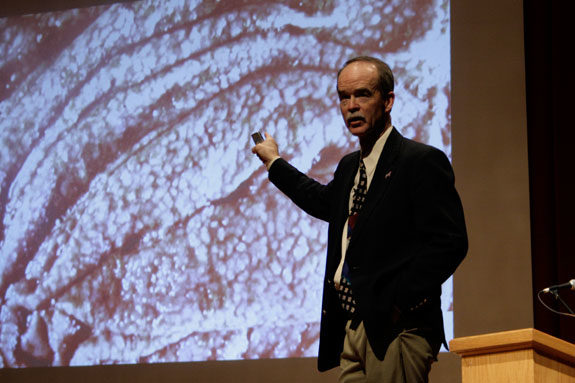That needs to change both in practice and in public relations efforts, Sides said. He addressed the issue with a presentation titled "Where Would the Beef Industry Be Without Technology" at the Intermountain Rangeland Symposium, held in Twin Falls, Idaho on Jan. 13 and 14. The event was sponsored by the University of Idaho and Idaho Rangeland Resource Commission.
Click here to read about the wolf impact discussion at the Rangeland Symposium
Several factors may change that support cheap beef prices, click here to read. Or view the video below.
Producers should avidly defend the technology made in ag science that has led to efficiency and fewer wasted resources, Sides said. From the polio vaccine, to Dr. Norman Borlaug’s Nobel Prize-winning work with genetically modified grain, technology has saved lives, and in ag’s case – fed the entire world.
But producers still have a ways to go in embracing technological advances.
“Folks we have forgotten heterosis,” Sides said, noting how the majority of cattle are now black-hided. “We have forgotten cross-breeding’s longevity of the cow, (and) performance in the feedlot.”
A cross-bred calf will have “an 80 dollar bill attached to it over the straight-bred calf of either breed you cross it with. And we’ve forgotten it.”
Synchronization is likewise a procedure that saves money and labor, but hasn’t caught on with producers.
“Brazil buys three times more doses of beef semen than we do and they’re a third-world country. There are techniques to synchronize heifers where I get 70 percent bred first service conception rate … and we don’t use it.”
Growth enhancement technology and implants are tools that are commonly criticized by those outside ag. But Sides called the science extremely useful since it reduces the land required to produce a pound of beef, as well as greenhouse gas emissions cited by environmental critics.
Comparing implanted cattle to that which hasn’t been implanted, has shown no great price comparisons on auction sites and university studies, Sides said.
“There is a difference if you have a signed contract with someone who says they’re going to buy your non-implanted cattle. And that’s great -- fill that niche. But make sure they pay you what it’s worth not to use implants and ionophores in antibiotics. If I go from 500-pound calf to 1,200-pound finish weight on a hormone free antibiotic free program, you need 150 dollars a head just to break even. Make sure you get that.”
Sides called parasite controls “the number one technology we have in our business, across all the different technologies."
"When I kill parasites, conception rates, weaning rates, carcass qualities, and feed efficiency, it is huge. It’s our number one technology, more so than anything else, from cow-calf operations to feedlot operations I get my greatest bang for a dollar investing in killing parasites, because of their effect on feed intake.” ![]()
PHOTO
Dr. Gary Sides of Pfizer Animal Health said technological advances are worth defending by livestock producers, especially related to efficiency in animal health. Photo by David Cooper.







